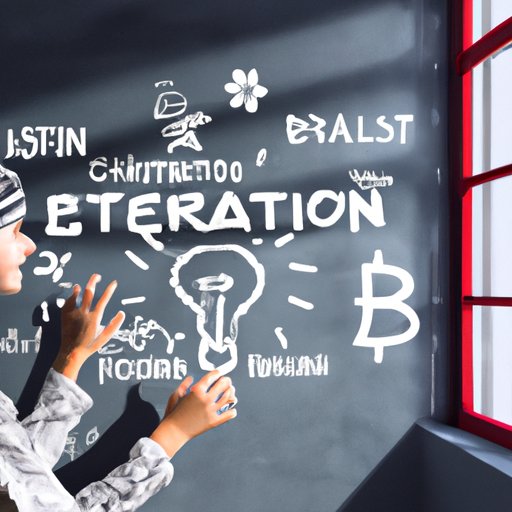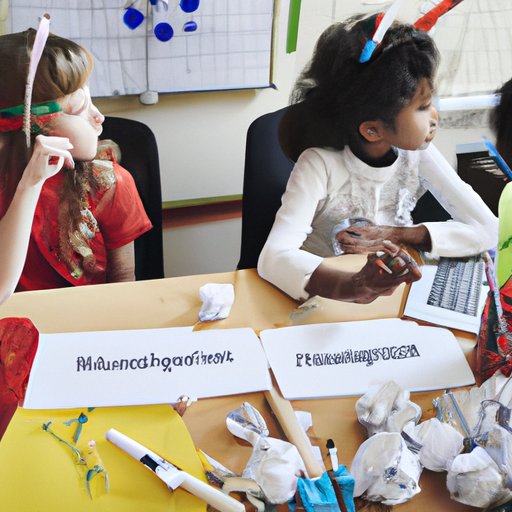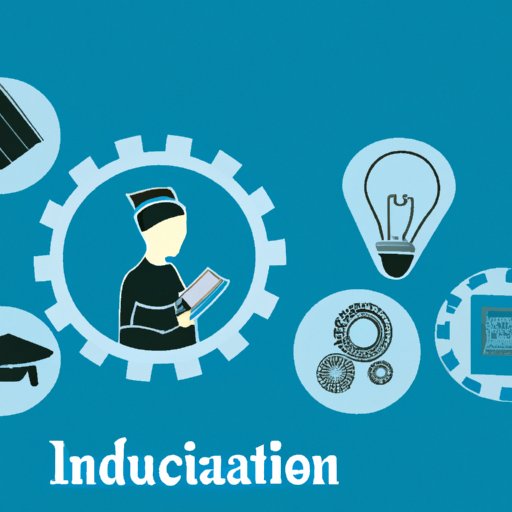Introduction
Innovation in education is the process of introducing new ideas, strategies, and technologies to improve the quality of teaching and learning. It is a way to promote creativity and critical thinking among students and make learning more engaging and enjoyable. This article will explore the benefits of innovative educational strategies, how technology is transforming education, different types of innovative learning approaches, and the impact of innovation on student outcomes.

Exploring the Benefits of Innovative Education Strategies
Innovative education strategies can have a positive impact on student engagement, access to resources, performance, and collaboration. Here are some of the key benefits:
Improved Student Engagement
Innovative education strategies can help to increase student engagement by making learning more interactive and enjoyable. For example, project-based learning encourages students to work together to solve real-world problems, while flipped classrooms allow students to take an active role in their own learning. These strategies can help to keep students motivated and engaged in the learning process.
Increased Access to Resources
Innovative education strategies can also help to increase student access to resources. For example, the use of digital platforms, such as online learning tools, can give students access to a wealth of information that would otherwise be unavailable. Similarly, the use of artificial intelligence can provide students with personalized instruction and feedback.
Increased Student Performance
Innovative education strategies can also help to increase student performance. For example, project-based learning encourages students to think critically and develop problem-solving skills, while flipped classrooms allow students to learn at their own pace and receive individualized instruction. These strategies can help to improve student achievement and prepare them for future success.
Enhanced Collaboration
Finally, innovative education strategies can help to enhance collaboration between students and teachers. For example, the use of online learning tools can facilitate communication between students and teachers, while project-based learning encourages students to work together to come up with creative solutions. These strategies can help to foster a collaborative learning environment and promote teamwork.

Examining How Technology is Transforming Education
Technology has had a major impact on the way education is delivered. Here are some of the ways technology is transforming education:
Use of Digital Platforms
Digital platforms, such as online learning tools, are becoming increasingly popular in education. They provide students with access to a wealth of information and allow them to collaborate with their peers and teachers from anywhere in the world. Additionally, these platforms can be used to create virtual classrooms, which can make learning more engaging and efficient.
Use of Online Learning Tools
Online learning tools, such as video conferencing and digital simulations, can help to make learning more interactive and engaging. These tools can also provide students with personalized instruction and feedback, which can help to improve their performance. Additionally, online learning tools can be used to create virtual classrooms, which can help to reduce costs and provide greater access to resources.
Use of Artificial Intelligence
Artificial intelligence (AI) is being used to create personalized learning experiences for students. AI-powered systems can analyze data to identify patterns and create individualized lesson plans that can help students to progress at their own pace. Additionally, AI can be used to provide detailed feedback on student performance, which can help to improve student outcomes.
Exploring Different Types of Innovative Learning Approaches
There are many different types of innovative learning approaches that can be used to engage students and enhance their learning experience. Here are some of the most popular:
Project-Based Learning
Project-based learning is a type of learning approach that encourages students to work together to solve real-world problems. In this approach, students are given a problem to solve and must develop a plan to solve it. This type of learning encourages students to think critically, develop problem-solving skills, and work together as a team.
Flipped Classrooms
Flipped classrooms are a type of learning approach that flips traditional classroom instruction on its head. In this approach, students watch lectures and do homework outside of class and then use class time to discuss, collaborate, and apply what they’ve learned. This type of learning allows students to learn at their own pace and receive individualized instruction.
Experiential Learning
Experiential learning is a type of learning approach that encourages students to learn through direct experience. In this approach, students participate in activities such as field trips, internships, and hands-on projects to gain a deeper understanding of the subject matter. This type of learning promotes creativity and critical thinking and allows students to apply what they’ve learned in the real world.
Examining the Impact of Innovation on Student Outcomes
Innovative education strategies can have a positive impact on student outcomes, such as improved test scores, attitude toward learning, self-esteem, and confidence. Here are some of the key benefits:
Improved Test Scores
Innovative education strategies can help to improve student test scores. For example, project-based learning encourages students to think critically and develop problem-solving skills, while the use of online learning tools can provide students with personalized instruction and feedback. These strategies can help to improve student performance on tests and other assessments.
Improved Attitude Toward Learning
Innovative education strategies can also help to improve student attitude toward learning. For example, flipped classrooms allow students to take an active role in their own learning, while experiential learning encourages students to learn through direct experience. These strategies can help to make learning more enjoyable and engaging for students.
Improved Self-Esteem and Confidence
Finally, innovative education strategies can help to improve student self-esteem and confidence. For example, project-based learning encourages students to work together and come up with creative solutions, while the use of online learning tools can provide students with personalized instruction and feedback. These strategies can help to boost student self-esteem and confidence and prepare them for future success.

Investigating What Innovative Education Looks Like in Practice
Innovative education is being implemented in schools around the world, but it is important to understand the common challenges and strategies for success. Here are some key takeaways:
Examples of Innovative Learning Programs
There are many examples of innovative learning programs that are being implemented in schools around the world. For example, some schools are using flipped classrooms to give students more control over their learning, while others are using project-based learning to help students develop problem-solving skills. Additionally, some schools are using online learning tools and artificial intelligence to create personalized learning experiences for students.
Common Challenges
Implementing innovative education strategies can be challenging. For example, there may be a lack of resources or support from school administrators. Additionally, there may be resistance from teachers who are hesitant to change their teaching methods. It is important to address these challenges and come up with strategies to overcome them.
Strategies for Success
In order to ensure success, it is important to have a clear plan of action. This should include setting measurable goals, developing a timeline, and identifying resources. Additionally, it is important to involve all stakeholders, such as teachers, students, and parents, in the process. This can help to ensure that everyone is on board and that the implementation of the program is successful.
Conclusion
In conclusion, innovation in education can have a positive impact on student engagement, access to resources, performance, and collaboration. Technology is transforming education and there are many different types of innovative learning approaches that can be used to engage students and enhance their learning experience. Additionally, innovation in education can have a positive impact on student outcomes, such as improved test scores, attitude toward learning, self-esteem, and confidence. Finally, it is important to understand the common challenges and strategies for success when implementing innovative education strategies.
Innovative education strategies can be a powerful tool for improving student outcomes. However, it is important to understand the potential benefits and challenges before implementing any new strategies. By taking the time to understand the impact of innovation in education, educators can ensure that their students are receiving the best possible learning experience.
(Note: Is this article not meeting your expectations? Do you have knowledge or insights to share? Unlock new opportunities and expand your reach by joining our authors team. Click Registration to join us and share your expertise with our readers.)
